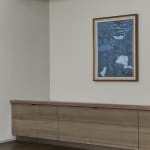Ikeda Yōson (1895−1988)
Rice Paddy in Winter
Color on paper, framed (30P)
With a label signed by the artist
Seal: Yo
91 x 65.2 cm
106 x 80 cm (overall)
With a label signed by the artist
Seal: Yo
91 x 65.2 cm
106 x 80 cm (overall)
Further images
Literature
“Ikeda Yoson zen tokushu.” Asahi Gallery. August 1978, 19.
The snow covered on the harvested paddy fields eventually thawed in the last days of the winter. Either is it because of the sunlight, or being shoveled off the pathway, the melting snow in the foreground seemed to freeze again at night, glowing in watery blue. The little white dots piled upon the black stubbles suggest the snow fell a little this morning again. Those details reveal the changing of the weather for the past few days and the passage of the time from last night. This work was executed in 1975, when Ikeda Yoson was at eighty. Inspired by those unobtrusive stubbles of the paddy fields or added a single flower to the scene, Yoson shows his novelty in composition, as well as keeps conveying a sense of spry, both of which are rarely found in an artist’s work of his late years. This painting could be also thought as the forerunner of Yoson’s renowned Santoka series ten years afterwards. It is supposed to be wintry; yet, the whole scene is very characteristic of Yoson, imparting the artist’s temperament, which is immersed in a soft, warm atmosphere as if the spring is around the corner and we could even feel the new, tiny lives beneath the soil are in bud.
Ikeda Yoson (nihonga painter; 1895−1988)
Okayama-born nihonga painter. His real name is Shoichi. Graduated from the Kyoto City School of Arts. Learned yoga at Matsubara Sangoro’s private school, Tensai-gajuku. Later became a disciple of Chikujo-kai founded by Takeuchi Seiho. Established a style of vivid colored landscapes using bird’s eye view under the influence of Tomita Keisen. Co-founded Suimei-kai and Sosei-sha with Uemura Shoko and Hamada Kan respectively. Founded his private school, Seito-sha, devoting to the cultivation of young painters. Also appointed a jury in Shin-bunten and Nitten. Consultant to Nitten. Member of the Japan Art Academy. Designated as a Person of Cultural Merit, and received the Order of Culture.
Ikeda Yoson (nihonga painter; 1895−1988)
Okayama-born nihonga painter. His real name is Shoichi. Graduated from the Kyoto City School of Arts. Learned yoga at Matsubara Sangoro’s private school, Tensai-gajuku. Later became a disciple of Chikujo-kai founded by Takeuchi Seiho. Established a style of vivid colored landscapes using bird’s eye view under the influence of Tomita Keisen. Co-founded Suimei-kai and Sosei-sha with Uemura Shoko and Hamada Kan respectively. Founded his private school, Seito-sha, devoting to the cultivation of young painters. Also appointed a jury in Shin-bunten and Nitten. Consultant to Nitten. Member of the Japan Art Academy. Designated as a Person of Cultural Merit, and received the Order of Culture.







